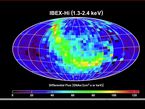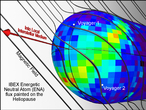First all-sky maps
Rumble at the edge of the solar system
As the solar wind travels outward, it sweeps up newly formed "pickup ions," which arise from the ionization of neutral particles drifting in from interstellar space. IBEX measures energetic neutral atoms (ENAs) traveling at speeds of roughly half a million to two and a half million miles per hour. These ENAs are produced from the solar wind and pick-up ions in the boundary region between the heliosphere and the local interstellar medium.
The first all-sky maps developed by NASA's Interstellar Boundary Explorer (IBEX) spacecraft, the first mission to examine the global interactions occurring at the edge of the solar system, reveal these surprising and intense interactions between our home in the galaxy and interstellar space.
Since its launch last October, IBEX has used two novel ENA cameras to image and map the heliosphere's global interaction - these energy-resolved maps provide detailed information about this interstellar interaction. ENAs propagate in from all parts of the boundary and, by detecting their directions of arrival, IBEX builds up maps of this invisible region over a broad range of energies every six months.
While the Voyager spacecraft are providing pioneering point measurements of interactions in the interstellar boundary region at two locations, IBEX measurements demonstrate the importance of global observations. "The most astounding feature in the IBEX sky maps - the bright narrow ribbon - snakes through the sky between the Voyager spacecraft, where it remained completely undetected until now," McComas says.
IBEX provides global imaging much like a weather satellite provides data about global and regional weather patterns on Earth. Individual weather stations on the surface make detailed local measurements, but can miss the big picture if storms don't pass directly overhead.
More time is needed to fully understand the IBEX data; however, because the ribbon appears to be ordered by the direction of the local interstellar magnetic field outside the heliosphere, IBEX observations suggest that the interstellar environment has far more influence on the structure of the heliosphere than anyone previously believed. A closer look at segments of the ribbon shows fine structures, which suggests that ion densities may be significantly enhanced in highly localized regions at the interstellar boundary.
IBEX also has collected hydrogen and oxygen from the interstellar medium for the first time. As our heliosphere travels through the interstellar medium at speeds of 60,000 miles per hour, IBEX measures neutral particles entering the solar system.
These measurements help researchers better understand the interstellar space environment. IBEX observations also help address a serious challenge facing manned exploration because the interstellar boundary shields the solar system from the majority of galactic cosmic ray radiation.
Source: Southwest Research Institute
First all-sky maps
Rumble at the edge of the solar system
As the solar wind travels outward, it sweeps up newly formed "pickup ions," which arise from the ionization of neutral particles drifting in from interstellar space. IBEX measures energetic neutral atoms (ENAs) traveling at speeds of roughly half a million to two and a half million miles per hour. These ENAs are produced from the solar wind and pick-up ions in the boundary region between the heliosphere and the local interstellar medium.
The first all-sky maps developed by NASA's Interstellar Boundary Explorer (IBEX) spacecraft, the first mission to examine the global interactions occurring at the edge of the solar system, reveal these surprising and intense interactions between our home in the galaxy and interstellar space.
Since its launch last October, IBEX has used two novel ENA cameras to image and map the heliosphere's global interaction - these energy-resolved maps provide detailed information about this interstellar interaction. ENAs propagate in from all parts of the boundary and, by detecting their directions of arrival, IBEX builds up maps of this invisible region over a broad range of energies every six months.
While the Voyager spacecraft are providing pioneering point measurements of interactions in the interstellar boundary region at two locations, IBEX measurements demonstrate the importance of global observations. "The most astounding feature in the IBEX sky maps - the bright narrow ribbon - snakes through the sky between the Voyager spacecraft, where it remained completely undetected until now," McComas says.
IBEX provides global imaging much like a weather satellite provides data about global and regional weather patterns on Earth. Individual weather stations on the surface make detailed local measurements, but can miss the big picture if storms don't pass directly overhead.
More time is needed to fully understand the IBEX data; however, because the ribbon appears to be ordered by the direction of the local interstellar magnetic field outside the heliosphere, IBEX observations suggest that the interstellar environment has far more influence on the structure of the heliosphere than anyone previously believed. A closer look at segments of the ribbon shows fine structures, which suggests that ion densities may be significantly enhanced in highly localized regions at the interstellar boundary.
IBEX also has collected hydrogen and oxygen from the interstellar medium for the first time. As our heliosphere travels through the interstellar medium at speeds of 60,000 miles per hour, IBEX measures neutral particles entering the solar system.
These measurements help researchers better understand the interstellar space environment. IBEX observations also help address a serious challenge facing manned exploration because the interstellar boundary shields the solar system from the majority of galactic cosmic ray radiation.
Source: Southwest Research Institute









